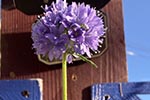Globe Gilia Is An Annual Not Perennial
As an annual, it shines bright but briefly. It also smells wonderfully but does not emit a strong fragrance like something bolder like night jasmine. It takes a while to blossom and when the flower does pop up, it is striking and prominent. We have a few in Lovie’s Pet Safe Garden in Northern California. They kind of look like a drag queen version of a dandelion: dramatic and stunning- absolutely fabulous. They can be found in the wild too throughout the state as a native plant to the state of California. We have a list of native California plants that thrive in containers and are pet friendly.
Rest assured that we check the flowers we feature on our site with the ASPCA and do extensive internet research for both the common and scientific name just to be super pet safe. If we cannot find direct reference, we check up to genus and so on until we can confirm whether a plant is toxic or non toxic to both cats and dogs. If we are not sure, or get contradictory information, we do not include it. Many of the plants featured we have grown successfully in our own pet safe garden in Northern California. You can see many of garden stars in photos from Lovie’s Pet Safe Garden.

Physical Attributes
Globe Gilia produces round, densely packed flower heads composed of many small tubular blooms in shades of blue, lavender, pink or white. The flower heads are about 1 inch wide on slender stems above a low-growing mound of finely divided green foliage. Plants grow 6-12 inches tall and wide.[1][2]
General Care Tips
Grow Globe Gilia in full sun and well-drained soil. Water regularly until established, then allow to dry slightly between waterings. Deadhead spent blooms to encourage continued flowering. Globe Gilia self-seeds readily. It is drought tolerant once mature. Divide clumps every 2-3 years to rejuvenate.[1][2]
Fun Facts
Globe Gilia is native to California and the southwestern United States. Its common name refers to the spherical shape of the flower heads. Also known as Globe Candytuft or Moss Gilia. Attracts butterflies and other pollinators. Deer resistant due to hairy foliage. Used in dried flower arrangements.[1][2]
Citations:
[1] https://www.thespruce.com/flowers-5092668
[2] https://www.picturethisai.com/wiki/Gilia_tricolor.html
[3] https://chartopia.d12dev.com/chart/28718/
[4] https://www.almanac.com/plant/fuchsias
[5] https://nibmehub.com/opac-service/pdf/read/The%20Complete%20Guide%20to%20Saving%20Seeds.pdf
| Consideration | Details |
|---|---|
| Container Friendly | Yes, can be grown in containers.[1][4] |
| Indoor/Outdoor | Outdoor[1][2][3][4] |
| Sun/Shade | Full sun to partial shade[1][2][3][4] |
| Perennial/Annual | Annual[1][2][3][4] |
| Flowering | Round, densely packed blue, lavender, pink or white flower heads in spring and summer.[1][2][3] |
| Drought Tolerant | Yes, drought tolerant once established.[1][2][3] |
| Pollinator Magnet | Yes, attracts bees, butterflies and other pollinators.[1][2][3] |
| Beginner Friendly | Yes, easy to grow from seed.[1][2][3][4] |
| Good Ground Cover | No, grows 6-36 inches tall.[1][2][3][4] |
| Good Privacy Screen | No, not tall enough for a privacy screen. |
| Invasive/Spreader | Self-seeds readily but not considered invasive.[1][3] |
| Hearty/Delicate | Hearty annual that can tolerate poor soils.[2][3] |
| Rodent Repellent | Unknown, but hairy foliage may deter some rodents. |
| Deer Resistant | Yes, deer resistant due to hairy foliage.[1][3] |
| Ideal States | Native to western states like California, but can be grown across many regions. Check out our list of pet friendly California Native plants! [1][2][3][4] |
Citations:
[1] https://www.gardeningknowhow.com/ornamental/flowers/gilia-flowers/globe-gilia-plant-tips-for-growing-gilia-wildflowers.htm
[2] https://northwestmeadowscapes.com/products/globe-gilia-gilia-capitata
[3] https://plants.ces.ncsu.edu/plants/gilia-capitata/
[4] https://silverfallsseed.com/product/gilia-globe/
[5] https://www.picturethisai.com/wiki/Gilia_tricolor.html





